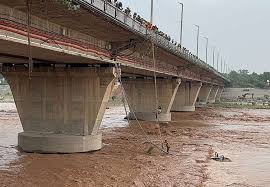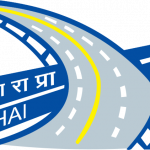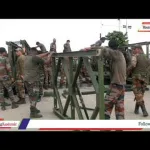Srinagar, June 25: In a joint operation, nine persons, including a labourer and several people performing religious rituals, were rescued from the swollen Tawi River in Jammu on Wednesday.
The rescue effort was led by the Jammu and Kashmir Police in collaboration with the State Disaster Response Force (SDRF) following the sudden rise in water levels due to heavy rainfall that disrupted normal life across the Union Territory.
The first to be trapped was 52-year-old MadanLal, a labourer engaged in sand extraction, who found himself stranded near the Tawibridge in Jammu city around 8:45 a.m. As the river’s water level surged rapidly, Lal was trapped for nearly two hours before SDRF personnel lowered a ladder from the bridge to rescue him safely.
In addition to Lal, eight more people were rescued in a coordinated effort involving the police, traffic officers, SDRF, and local volunteers. Several of those rescued were performing pinddaan, a Hindu ritual for the deceased, when they were caught off guard by the swiftly rising waters. The operation also saw the rescue of several horses that had been trapped in the river during the downpour.
Elsewhere in the region, heavy rainfall triggered landslides and roadblocks, particularly along the Jammu-Srinagar National Highway. A spokesman from the Traffic Department said that mudslides at Mehad and near the T2 tunnel in Ramban district around 6:30 a.m. temporarily halted traffic movement in both directions. However, road clearance teams acted swiftly, and traffic resumed after more than three hours of disruption.
In Rajouri district, an overflowing stream caused a flood-like situation in parts of Rajouri town, including Kheora, Lower Jawahar Nagar, and Thudi. The sudden deluge swept away a couple of vehicles parked along the stream’s banks, though fortunately, no casualties were reported.
According to the Meteorological Department, Katra town in Reasi district received the highest rainfall over the past 24 hours, with 108.5 mm, followed by Rajouri at 80 mm, Udhampur at 71.4 mm, Poonch at 48 mm, and Ramban at 47.5 mm.
Dr.Mukhtar Ahmad, Director of MeT Srinagar, told Rising Kashmir that more rain is expected over the coming days, with a high possibility of localised flooding in vulnerable areas. “The forecast suggests scattered rainfall from June 28 to 30, followed by brief spells on July 1 and 2. On July 3, as the AmarnathYatra commences, hot and humid weather is expected, with brief showers in some locations,” he added.
Meanwhile, Srinagar city recorded its highest-ever minimum temperature for June, logging a night-time low of 25.0°C, surpassing the 47-year-old record of 24.6°C set on June 19, 1978. Daytime temperatures across the region remained above normal, with Srinagar recording a high of 32.5°C, Kupwara at 32.8°C, Jammu at 32.6°C, and Qazigund at 30.2°C. Other temperature readings included Pahalgam at 27.4°C, Batote at 26.2°C, and Gulmarg at a cooler 23.2°C.
The MeT Department has issued an advisory for June 25 to 27, forecasting generally cloudy skies with intermittent light to moderate rain and thundershowers across many places. There is also a forecast for heavy rain at isolated spots in the Jammu division.
Authorities have warned of the possibility of flash floods in vulnerable locations, landslides and mudslides in hilly areas, and waterlogging in low-lying plains. Farmers have been advised to suspend irrigation, spraying, and fertilizer application during this period to mitigate the impact of the adverse weather conditions.








